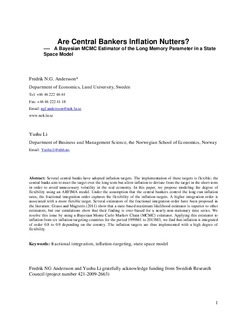| dc.description.abstract | Several central banks have adopted inflation targets. The implementation of these targets is flexible; the
central banks aim to meet the target over the long term but allow inflation to deviate from the target in the short-term
in order to avoid unnecessary volatility in the real economy. In this paper, we propose modeling the degree of
flexibility using an ARFIMA model. Under the assumption that the central bankers control the long-run inflation
rates, the fractional integration order captures the flexibility of the inflation targets. A higher integration order is
associated with a more flexible target. Several estimators of the fractional integration order have been proposed in
the literature. Grassi and Magistris (2011) show that a state-based maximum likelihood estimator is superior to other
estimators, but our simulations show that their finding is over-biased for a nearly non-stationary time series. We
resolve this issue by using a Bayesian Monte Carlo Markov Chain (MCMC) estimator. Applying this estimator to
inflation from six inflation-targeting countries for the period 1999M1 to 2013M3, we find that inflation is integrated
of order 0.8 to 0.9 depending on the country. The inflation targets are thus implemented with a high degree of
flexibility. | nb_NO |
